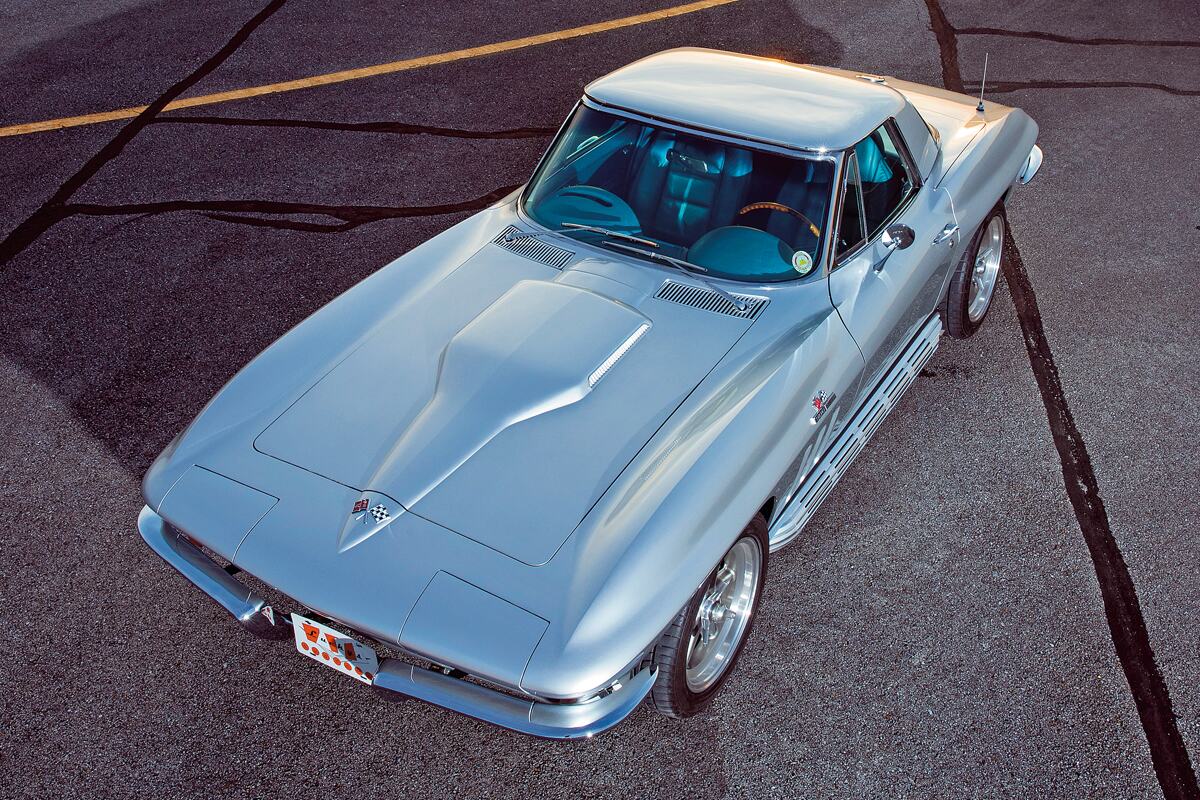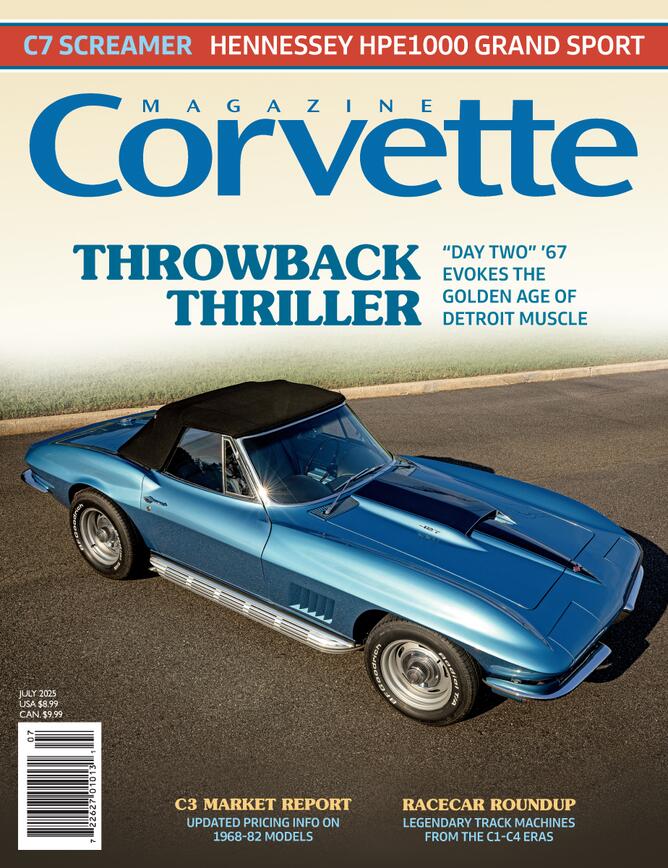Jim Hornaday is sometimes suddenly and violently jolted awake from a sound sleep by the same recurring nightmare: The remnants of another severely battered and neglected second-generation Corvette that he could have saved, if only given the opportunity, slips away into eternal oblivion. But here in the waking world, Hornaday can and will do whatever is required to bring these cars back and give them a brand-new lease on life.
Our featured 1965 convertible is a perfect example of his relentless quest to save every Midyear he encounters, regardless of how little is left or how hopeless the average person thinks it might be. He first laid eyes on its sad remnants in the sales lot at the Corvettes at Carlisle show in Pennsylvania. It amounted to a birdcage (the steel substructure surrounding the passenger compartment, to which the fiberglass body panels were attached), the firewall, and part of the floor.
With a tinge of sarcasm, Hornaday tells us that “Mike McKown, a member of an organization of seriously committed enthusiasts called the Vetteheads, brought his prized possession to Carlisle in search of fame and fortune. The [car’s] pulse was weak, but she still had some life left in her, so I could not allow her to be lost.”

After a brief negotiation the forlorn ’65 Corvette was on its way to Hornaday’s home in Alabama. He immediately dove in by doing a thorough assessment of the aforementioned birdcage and formulating a plan to rehabilitate this crucial assembly. Rusty areas were cut out and replaced with new sections, which are readily available from aftermarket suppliers. Hornaday has considerable experience restoring these structures, and as usual he took great care to maintain the correct shape of this one by temporarily reinforcing the surrounding areas before cutting out rotted sections.
After all metal work was completed, the birdcage went to Jim Durham’s house for installation of the body panels. The two Jims, car owner Hornaday and friend Durham, and two more friends, Danny Heston and Matt Horn, worked together to “build up” the body exactly as Chevrolet originally did, starting with fiberglass bonding strips being riveted to the substructure. The outer body panels were then bonded to these strips. This technique was originally used because back in the 1960s, it was not feasible to use structural adhesives to bond the outer fiberglass panels directly to the steel birdcage.
Hornaday was very fortunate to acquire an entire, original rear body section for the car. “The rear clip on this car belonged to Lee Miller of Toney, Alabama,” he explains. “Mr. Miller had approximately 20 Corvettes in various states of repair, and he was not known to part with anything, as he hoped to use everything he had for his own projects. I visited him and asked if he would sell me the rear clip, and he initially declined. When I told him I intended to put his name on the back of it, he said, ‘Please take it.’

“Unfortunately he passed away before the car was finished. But when it was completed, I asked his widow, Jane, to take pictures of the car with the [name] badge applied. I also presented her with a copy of the badge. [It] still resides on the rear of the car, paying tribute to another Corvette collector who left his mark on this great hobby we share.”
Complete, original C2 front clips are virtually impossible to find, so the choice came down to buying a jig-assembled reproduction nose or assembling one piece-by-piece using NOS and reproduction panels. The four gentlemen restoring the body did the latter, taking great care to make sure each panel was in correct alignment, and every gap was tight and consistent. Though this car was not equipped with the 1965-only, optional 396-ci engine, Hornaday chose to use the special hood that came with those cars simply because he thinks it’s beautiful. To finish the look, he added complementary “396 Turbo-Jet” emblems to the front fenders.
Once all of the panels were installed, the now-complete body was transported to Lucky’s Restoration in Athens, Alabama. There, Seth Wood and his colleagues “made all of the imperfections go away” by massaging the fiberglass and block-sanding several coats of high-build primer, explains Hornaday. When the body’s surface was as close to perfect as they could get it, Wood sprayed a color called Blade Silver using a two-stage, water-borne paint system.

While Wood and the crew at Lucky’s were working their magic on the body and paint, Hornaday turned his full attention to the chassis and mechanical components. As with previous builds he’s done, he wanted to retain the overall stock look of a Midyear Corvette while endowing the car with greatly improved ride and handling characteristics.
To achieve these goals he contacted Tray Walden, owner of Street Shop Chassis in Athens, Alabama, and ordered the company’s C4-based custom package. This setup uses mandrel-bent, 2×4-inch steel tubing and offers significantly increased torsional stiffness, as well as slightly lower mass, compared with the stock C2 frame. And in keeping with Hornaday’s desire to maintain a stock look, the Street Shop chassis accepts a bone-stock C2 body, without the need to cut and reconfigure the floor or wheel wells.
The chassis can be set up to use a wide variety of different engines and transmissions, as well as different suspension, brake, and drivetrain configurations. Hornaday chose to use mostly stock C4 components for the suspension, steering, and binders, including 1996 Grand Sport slotted-and-drilled rotors. Motive power comes from a new GM crate LS3 that delivers a reliable 480 horsepower from 6.2 liters of displacement. The engine’s twist goes through a Tremec five-speed manual gearbox back to a Dana 44 rear end.

After getting the fully finished and painted body back from Lucky’s Restoration, Hornaday carefully bolted it down to the completed Street Shop chassis. To maintain a period look while enhancing performance, he ordered a set of custom BR series rims from Vintage Wheels in San Diego. The six-spoke design, understated finish, and center-hub knock-off retainers with three-ear spinners look right out of the 1960s, but modern manufacturing techniques make them super strong, and their size allows for larger, high-performance tires.
“Tray at Street Shop provided the exact wheel specifications,” recalls Hornaday, “to allow them to fit under the stock body with Firestone Firehawk tires, sized at 245/45R17 in front and 275/40R17 in the back.” These are more than twice the width of an original 7.75×15 1965 Corvette tire, and that increased contact patch, along with their modern design, improves every aspect of the car’s handling performance.
To complete the exterior look he wanted, Hornaday installed a hardtop and factory side exhaust. The former item, sourced from a 1963 Corvette, is painted Blade Silver to match the body, and it gives the convertible a distinctive appearance. Besides looking fantastic, the side pipes deliver an exhaust note that’s beautifully aggressive.

As with the exterior, Hornaday wanted the car’s interior to look stock, but he did make a concession when it came to the seats. While it would have been relatively simple to find buckets with greater support and comfort that readily fit into the car, he went in the opposite direction and chose perhaps the most challenging seats possible. They were sourced from a Cadillac XLR, and the first problem was their height, which was several inches taller than an original ’65 Corvette bucket. Though they fit inside the car, they looked totally out of proportion. The solution to that was to strategically cut 4.5 inches out of the frames and then weld them back together.
The second, far more formidable challenge was getting all of the XLR seat features to function. When installed in the Cadillac they were designed for, the car’s body-control module (BCM) enabled the integral heat, air conditioning, and many positional adjustments to work. Finding space to hide an XLR BCM in an old Corvette and then getting it to work were extremely difficult, so Hornaday found another solution, courtesy of friend Paul Dove, whom Hornaday calls “an engineering genius.”
Dove, who works as an engineering scientist at NASA’s U.S. Space and Rocket Center in Huntsville, Alabama, designed and fabricated stand-alone modules that enable every feature in each seat to operate correctly. To further the seat’s resemblance to stock units, Al Knoch Interiors custom-made new covers with a pattern that looks close to original 1965 Corvette seats while fitting the cut-down XLR frames properly.

For summer driving comfort Hornaday added an air-conditioning system from Classic Air, and in keeping with the stock theme throughout, he chose to use original-style ducting inside the car. A cruise-control setup and power windows further enhance the car’s operational civility.
Aside from the upgraded seats, the remainder of the car’s interior is stock, or at least stock-appearing, with door panels, dash pads, carpet, and remaining soft-trim items supplied by Al Knoch. An original teak-and-rosewood steering wheel, optional in Corvettes in 1965-66, beautifully complements the blue interior. The wheel mounts to another desirable feature that was optional in 1965, an original telescoping steering column.
Since completing the build Hornaday has driven this car about 3,000 joy-filled miles. That may not sound like a lot, but considering he owns more than a dozen Corvettes, and every one of them gets driven with some regularity, it’s pretty impressive. Besides the sheer pleasure of driving a car that so adeptly blends the gorgeous appearance of a Midyear Corvette with modern performance and amenities, Hornaday derives an immeasurable degree of satisfaction knowing that, with help from some good friends, his tenacity, hard work, and sheer will helped save another one.






